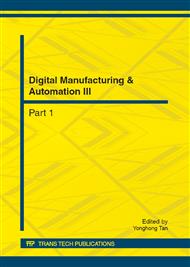[1]
C.C. Adams, The Knot Book: An Elementary Introduction to the Mathematical Theory of Knots. San Francisco, CA: Freeman, (1994).
Google Scholar
[2]
J. Takamatsu, T. Morita, K. Ogawara, et al. Representation for Knot-Tying Tasks,. IEEE Transactions on Robotics, 22(1), 2006. pp.65-78.
DOI: 10.1109/tro.2005.855988
Google Scholar
[3]
H. Mayer, I. Nagy, A. Knoll, et al. Adaptive control for human-robot skill transfer: trajectory planning based on fluid dynamics,. Proceedings of IEEE International Conference on Robotics and Automation, 2007. pp.1800-1807.
DOI: 10.1109/robot.2007.363583
Google Scholar
[4]
H. Mayer, F. Gomez, D. Wierstra, et al. A System for Robotic Heart Surgery that Learns to Tie Knots Using Recurrent Neural Networks,. Proceedings of the 2006 IEEE/RSJ International Conference on Intelligent Robots and Systems October 9 - 15, 2006, Beijing, China. pp.543-548.
DOI: 10.1109/iros.2006.282190
Google Scholar
[5]
J.V.D. Berg, S. Miller, D. Duckworth, et al. Superhuman Performance of Surgical Tasks by Robots using Iterative Learning from Human-Guided Demonstrations,. 2010 IEEE International Conference on Robotics and Automation. May 3-8, 2010, Anchorage, Alaska, USA. pp.2074-81.
DOI: 10.1109/robot.2010.5509621
Google Scholar
[6]
Y. Yamakawa, A. Namiki, M. Ishikawa, M. Shimojo. One-handed knotting of a flexible rope with a high-speed multifingered hand having tactile sensors,. Proceedings of the 2007 IEEE/RSJ International Conference on Intelligent Robots and Systems, 2007. San Diego, CA, USA, pp.703-708.
DOI: 10.1109/iros.2007.4399379
Google Scholar
[7]
H. Kang and J.T. Wen. EndoBot: a Robotic Assistant in Minimally Invasive Surgeries,. Proceedings of the 2001 IEEE International Conference on Robotics & Automation. Seoul, Korea. May 21-26, 2001. p.2031-(2036).
DOI: 10.1109/robot.2001.932906
Google Scholar
[8]
H. Mayer, F. Gomez, D. Wierstra, et al. A system for robotic heart surgery that learns to tie knots using recurrent neural networks,. International Conference on Intelligent Robots and Systems, 2006, Beijing, pp.543-548.
DOI: 10.1109/iros.2006.282190
Google Scholar
[9]
N. Padoy, G.D. Hager. 3D Thread Tracking for Robotic Assistance in Tele-surgery,. 2011 IEEE/RSJ International Conference on Intelligent Robots and Systems, 2011, San Francisco, p.2012-(2017).
DOI: 10.1109/iros.2011.6094906
Google Scholar
[10]
L.W. Yue, Y. Cao, S.X. Wang, H.J. Wang. Twisting Knot Tying Method of Suture-A Novel Method for Robotic Knot Tying,. 2007 IEEE/ICME International Conference on Complex Medical Engineering. pp.87-91.
DOI: 10.1109/iccme.2007.4381698
Google Scholar
[11]
L. Wang, Y. Yang, F.X. Sun, et al. Design of a Corneal Suturing Nail Based on Shape Memory Alloy,. Chinese Journal of Mechanical Engineering, 2010, 46(5), pp.105-109.
DOI: 10.3901/jme.2010.23.161
Google Scholar
[12]
A. Lendlein, R. Langer. Biodegradable, elastic shape-memory polymers for potential biomedical applications,. Science 31 May 2002, Vol. 296, no. 5573, pp.1673-1676.
DOI: 10.1126/science.1066102
Google Scholar
[13]
X.X. Xuan. Research on corneal suturing robot design and suture identification, Master Dissertation of Beihang University, Beijing, China. (2008).
Google Scholar


